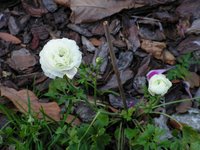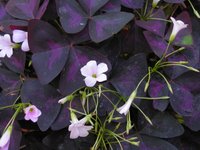- Continual bloom (good luck!)
- Floriferous
- Disease resistance
- Relatively carefree (I have no idea what that could mean – all roses here have roughly the same needs.)
Hybrid Tea
- Double Delight
- Mr. Lincoln (I grow it – a very vigorous, wonderful plant.)
- Veteran’s Honor
- St. Patrick (An excellent, very upright narrow bush with tight buds. The best rose for cutting, lasting a remarkable week or more.)
- Elina
- Loise Estes
- Bride’s Dream
- Gemini
- Moonstone
- The McCartney Rose
- Knock Out (I grow both the original cherry red and a very pretty light pink sport. First-rate landscaping rose, seemingly immune to black spot (not just resistant to it). Low water needs.)
- Belinda’s Dream
- Dortmund (A Kordes rose. Reputedly very disease resistant. I’ve not seen it for sale on Fortuniana rootstock, though.)
- Abraham Darby (A standout in my garden, too.)
- Heritage
- The Prince
- Charlotte
- The Dark Lady
- Graham Thomas
- Molineux
- Gold Medal (I bought under the name of AROyqueli. It was so diseased and stunted I got it for $1.50. So far, it’s doing well, but not many blooms.)
- Queen Elizabeth
- Cherry Parfait
- Tournament of Roses
- Bees Knees
- Butter Cream
- Fairhope
- Jean Kenneally
- Jeanne Lajoie
- Figurine
- Miss Flippins
- Kristin
- Pierrine
- Don Juan (An exceptional, vigorous, disease-tolerant rose. Don Juan is an oddity: At any point, it will have all stages of flowers, from new shoots, to bud to blown. The vast majority of roses go through cycles of bloom, where all the flowers are roughly in the same stage of bloom.)
- Prosperity (Another great recommendation. Extremely vigorous and disease resistant.)
- Fourth of July
- Cecile Brunner (Very vigorous, growing on its own rootstock. I bought mine for $4.50 from Seminole Springs Nursery. I planted mine a few months ago, and though it hasn’t bloomed, it’s already mounted my six-foot fence.)
- Altissimo
- Clotilde Soupert
- Red Cascade (I’d classify this as a rambling miniature rose. Perfect tiny red blooms. It grows very well in a small cage or tripod. Floriferous and the toughest rose I’ve ever grown.)
- Champney’s Pink Cluster (Bred by Champney in South Carolina. It’s the parent of the Blush Noisette and all the innumerable offspring of that rose.)
- Marechal Niel
- Louis Phillippe
- Mrs. B. R. Cant
- Souvenir de la Malmaison
- Mutabilis (There’s a wonderful example of this rose growing at Freedom Playground here in DeLand.)
- Pink Pet
- Blush Noisette
- Duchesse de Brabant
- Paul Neyron
- Cramoisi Superieur
- Our Lady of Guadalupe
- Iceberg (My first rose!)
- Playgirl
- Sun Flare
- Miss Ada
- Hannah Gordon
- Betty Boop
- Europeana
- French Lace
















